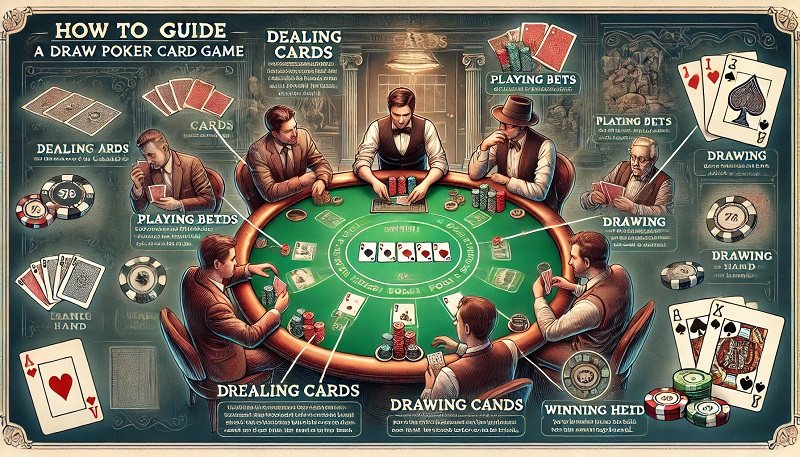
Draw Poker Card Game Guide
Draw poker is a classic and popular card game that has been enjoyed by players for many decades. Known for its simplicity and strategic depth, draw poker offers a unique blend of chance and skill, making it a favorite among both casual and serious card players. In this guide, we will explore the fundamentals of draw poker, its historical background, the rules of the game, and its current popularity, as well as the existence of draw poker tournaments.
What is Draw Poker and When Did It Appear?
Draw poker is a type of poker game where players are dealt a complete hand before the first betting round and then have the opportunity to change their hand by discarding and drawing new cards. The game typically involves five cards, making it known as “Five-card Draw Poker.” Players aim to make the best possible five-card hand from their initial hand and the cards they draw.
The origins of draw poker date back to the early 19th century in the United States. The game became popular during the American Civil War and has since evolved into various forms and variations. Its simplicity and engaging gameplay have contributed to its lasting appeal, making it a staple in home games and casinos alike.
History of Its Origin
Draw poker’s roots can be traced back to several different card games played in Europe and Persia. The game we recognize today began to take shape in the early 1800s in the American frontier. As people migrated westward, they brought with them different gambling games, which eventually led to the development of draw poker.
By the time of the American Civil War, draw poker had firmly established itself as a popular pastime among soldiers. The game’s straightforward rules and the element of skill involved made it a favorite in military camps. Post-war, draw poker continued to thrive, especially in the booming riverboat casinos along the Mississippi River.
Differences from Regular Poker
One of the primary differences between draw poker and other poker variants, such as Texas Hold’em or Omaha, is the drawing phase. In draw poker, after the initial betting round, players can discard a certain number of cards from their hand and draw new ones from the deck. This adds an additional layer of strategy, as players must decide which cards to keep and which to replace.
Another significant difference is the number of betting rounds. Draw poker typically has fewer betting rounds compared to games like Texas Hold’em. There is usually an initial betting round after the first deal and another after the draw. This streamlined betting process can make draw poker games faster-paced.
Lastly, the information available to players is different. In draw poker, players only see their own cards and the cards they draw, while in community card games like Texas Hold’em, players can see shared cards on the table. This makes draw poker more of a closed-information game, requiring keen observation and inference skills.
Rules of the Game
The basic rules of draw poker are relatively simple. Each player is dealt five cards face down. After the initial deal, a round of betting takes place, starting with the player to the left of the dealer. Players can choose to call, raise, or fold based on their initial hand.
Once the first betting round is complete, the drawing phase begins. Players can discard any number of cards from their hand, usually up to three, although some variations allow for more or fewer discards. The dealer then provides replacement cards from the deck.
After the draw, a second round of betting occurs. Players again have the option to call, raise, or fold. The player with the best five-card hand at the end of the betting rounds wins the pot. Standard poker hand rankings are used to determine the winner.
Common variations of draw poker include “Jacks or Better,” where players need at least a pair of jacks to open the betting, and “Deuces Wild,” where twos act as wild cards that can substitute for any other card.

How Popular is the Game?
Draw poker’s popularity has seen fluctuations over the years, often overshadowed by the rise of Texas Hold’em in the late 20th century. However, it remains a beloved game, particularly in home settings and among poker enthusiasts who appreciate its classic nature.
Online poker platforms also offer draw poker variants, catering to a niche audience who enjoy the traditional gameplay. The game’s simplicity and the strategic element of drawing new cards continue to attract players, keeping draw poker relevant in the ever-evolving world of card games.
In recent years, there has been a renewed interest in traditional poker games, including draw poker, as players seek to explore different poker formats and revisit classic games. This resurgence has helped maintain draw poker’s presence in both online and offline poker communities.
Are There Any Tournaments?
While draw poker tournaments are not as prevalent as Texas Hold’em or Omaha tournaments, they do exist. Some online poker sites and local poker clubs organize draw poker tournaments, providing opportunities for enthusiasts to compete in a structured format.
These tournaments often follow a similar structure to other poker tournaments, with players starting with a set number of chips and playing until one player has all the chips. The draw poker format adds a unique twist to the tournament experience, requiring players to adapt their strategies to the drawing phase.
Notable poker events, such as the World Series of Poker (WSOP), occasionally include draw poker events in their schedules. These tournaments attract skilled players who enjoy the challenge of draw poker and help keep the game alive in the competitive poker scene.
